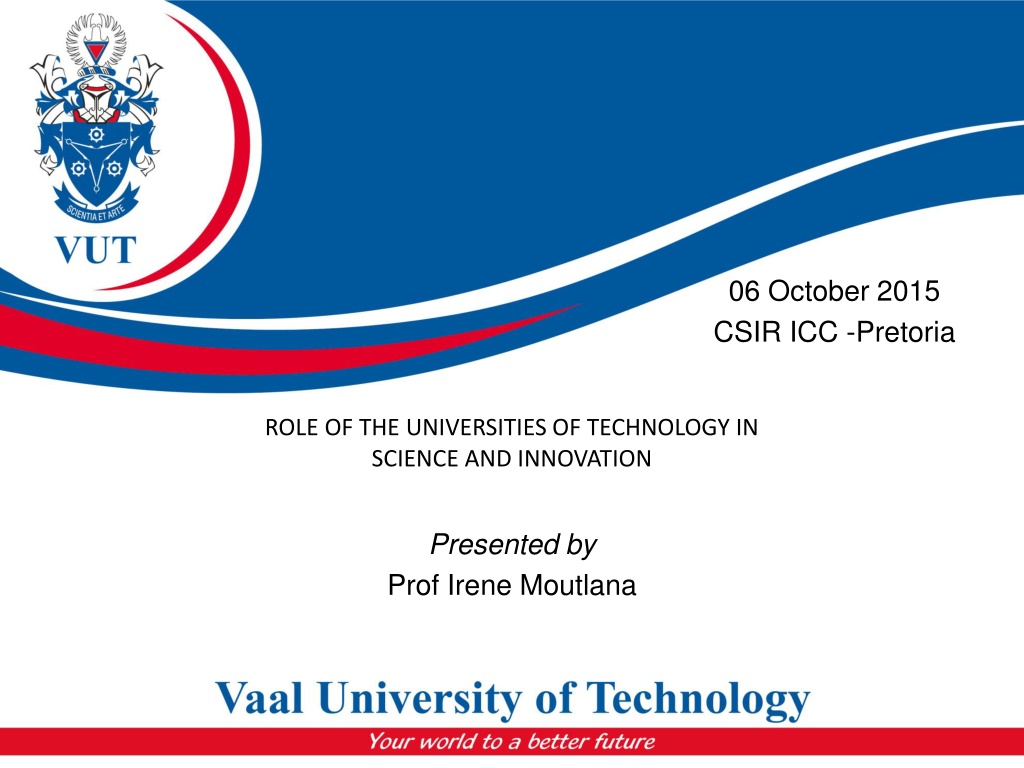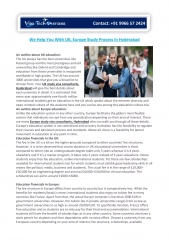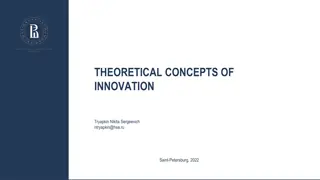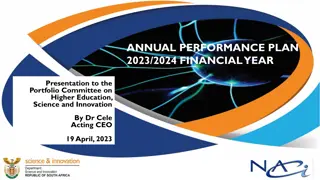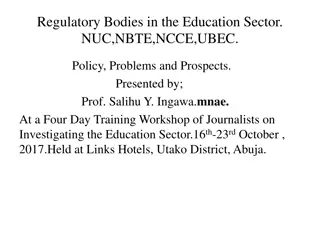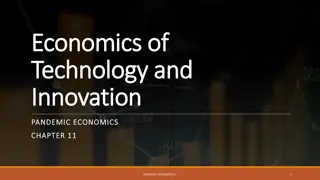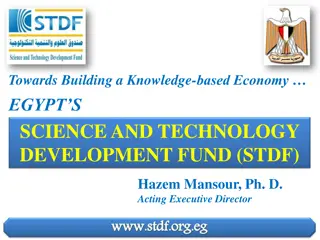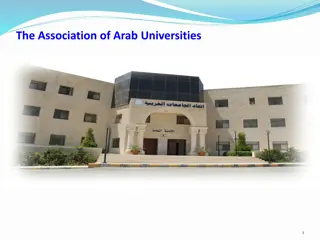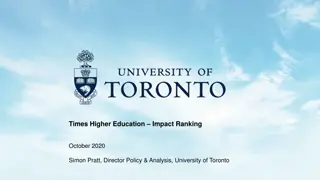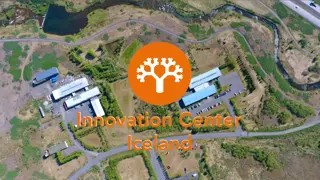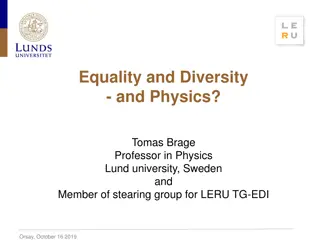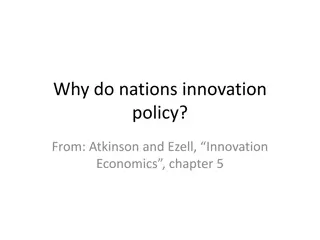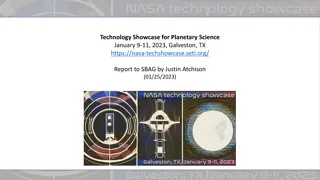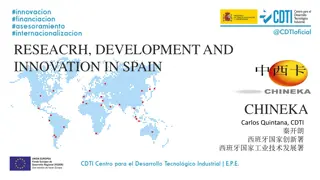Role of Universities of Technology in Science and Innovation
Introduction to the role of universities of technology in advancing science and innovation, highlighting the mandate of higher education institutions to create a conducive educational environment. The narrative explores the challenges and opportunities facing educational institutions, emphasizing the importance of forming strategic partnerships to address societal needs and concerns.
Download Presentation

Please find below an Image/Link to download the presentation.
The content on the website is provided AS IS for your information and personal use only. It may not be sold, licensed, or shared on other websites without obtaining consent from the author. Download presentation by click this link. If you encounter any issues during the download, it is possible that the publisher has removed the file from their server.
E N D
Presentation Transcript
06 October 2015 CSIR ICC -Pretoria ROLE OF THE UNIVERSITIES OF TECHNOLOGY IN SCIENCE AND INNOVATION Presented by Prof Irene Moutlana
INTRODUCTION Progress necessitates one surrender something, however small, because it represents change and with it, difference. The art behind its attainment lies in one s ability to convince people of its ultimate advantage. And that requires not only that they understand the change it demands, but that they invest in the opportunity it presents . And today is such a day. Gareth van Onselen (Business Day, 23/0/2011)
MANDATE The fundamental mandate of Higher Education is first and foremost its obligation to create the best possible educational environment for our young people whose lives are likely to be significantly changed during their years within this space called a university. We as Universities have thus both a distinctive responsibility and a precedent setting challenge. That teaching, learning, research community engagement as the core purpose of the University s key elements is regarded by [Trow in 1973] as the privatelife of Higher Education. Thus any changes in the countries constitution, orientations are likely to have a profound, perhaps then changes in the socio-economic, political cultural positioning of Higher Education which arguably are aspects of its publiclife . Higher Education, thus on the other hand has multiple engagements between mass Higher Education systems, society, economy and expert and technical exchanges which invariably shape both the normative constitution of Universities.
MANDATE Behind our often rosy progressive rhetoric s of change coming from the media, national commissions, politicians and our everyday lives, is another reality, of increasing inequalities and frightening levels of poverty, famine, joblessness, unemployment, disease, crime, violation of human rights, high failure and drop-out rates from institutions, inaccessibility for millions to educational benefits, corruption, mal-administration, coupled with an ever- decreasing resource base both in terms of human capital and skills. What seems to have compounded the vulnerability of our communities, is the perceived crisis of educational leadership, failure during such critical periods
Formation of Strategic Partnerships Ladies and Gentlemen - These new progressive democratic rhetorics i.e. partnerships and alliances resulted in new dilemmas and concerns, that forced institutions to focus on how to create learning environments that will respond to the country s needs. Communities became even more vocal in expressing concerns about the learning opportunities offered to people by institutions and the private sector and government initiatives. These concerns have brought the integrity and value of tertiary institutions in fulfilling their promise of a fair chance to all, into question, above all the lack of proactive well planned and implementable delivery system are at the centre of the confrontational politic between government and its people.
The Question is: Where do UoTs fit into this? While institutional types and other organizational leaders are aware of these opportunities embraced within these challenges, it soon became apparent to us that the new knowledge demands seem to outrun both our human and physical resources, creating a state of disequilibrium between demand, effective leadership, and response capabilities. The latter in such a demand response equation have made institution and organization to fall badly out of balance in terms of qualifications, programmes, relevance and professional quality, and employability levels of their graduates. Ladies and Gentlemen - On the contrary, today economic success is largely determined by the quality and relevance of the information one possesses. Thus successfully transformed organizations are those that are innovative , entrepreneurial and capable to constantly reinvent themselves to better service the needs of society.
What is a UoT It is a University that offers technological career directed educational programmes. A University of Technology focuses on innovative problem solving research. A University of Technology engages with government/business/industry with communities as end users. Institutions focusing on developing programs and services to fill the gap described above are defined as the New Generation Universities (Marshall, 20006:3). These are institutions which are so-called instructionally focused and scholarly informed to maintain the balance between teaching and research, technology transfer and innovation, commercialization and meaningful application. Ironically the challenge of new technologies has facilitated revolutionary changes in social organizations, systems, families, workplaces, churches and educational institutions. While knowledge as dominant property played an important role, but ironically enough it is argued that it did not serve as the driving force behind the evolution of the political economy. On the contrary, today economic success is largely determined by the quality and relevance of the information one possesses. Thus successful transformed organizations are those that are innovative and capable to constantly reinvent themselves to better service the needs of society.
What is a UoT Traditional Universities are known for their wide range of disciplines offered through various degrees. Although technology is often used in the programme delivery or part of the curricula, technology is not the main focus of study. At a university of technology, technology is the object of study. In the study of science at a university and technological science at a university of technology, technological science has to do with the development of knowledge and not the collection of knowledge. The aim of study at a university is education for the sake of education. The aim of study at a UoT is preparation for the world of work to get a job or to create a job. UoTs make knowledge useful there is ample evidence of this.
Value proposition Model of UoT Hence our value proposition model as UoT s: The research and commercialization value chain can originate either from University-initiated research (innovation-push) or as a result of innovation required by an industry partner (market- driven). Our model will ensure that we nurture both approaches with activities at a balance of 30% research-push and 70% market-driven research.
Why UoTs have become sought after universities Application of technological knowledge; Training of technicians and technologists; A focus on applied research; Direct interaction with employment providers; Multidisciplinary subject (course) packages; Cost-effective and quality career-oriented education; Outcomes-based, demand-driven curricula; and Emphasis on immediate and productive employability and its relationship with industry.
Stakeholder perspective and expected outcomes Government expects the education and training offered by UoTs to be relevant for commerce, industry, public sector and the community at large. Students qualifying at UoTs must be employable and immediately productive. To ensure this, the UoTs must be in constant contact with employers (for example, through advisory committees) and the curricula of UoT programmes must prepare the students for the world of work. The question is: To what extent have we been successful in realizing these outcomes?
Unique factors of UoT Technology Incubation Platforms Business Incubation Platforms Industrialization platforms Cooperative Education Platforms Entrepreneurial Platforms Health Platforms E-Skilling Platforms Footwear and Manufacturing centre Energy Platforms
Unique factors of UoT Technology Incubation Platforms Business Incubation Platforms Industrialization platforms Cooperative Education Platforms Entrepreneurial Platforms Health Platforms E-Skilling Platforms Footwear and Manufacturing centre Energy Platforms
Implications of e-waste How E-waste poses significant risk to humans and the environment Organic pollutants known as polychlorinated biphenyls ( PCBs ). This class of pollutants includes copper, gold, iron, lead, thallium, and zinc, all of which can lead to birth defects. Hence as a learning system and enterprise Universities are not only learn and research this but have an obligation to ensure that those involved in the recycling and dismantling industry, do so in an environmentally friendly way. This operation will require limited infrastructural commitment but will afford the University an opportunity to offer a collection site for E-Waste from the University and the surrounding communities (Private and Public), training programmes for the recycling industry staff, courses for dismantling of e-waste products and job creation for communities around the university and for students within the university.
Energy Platforms To contribute to the improvement of service delivery of energy in the public service. This project includes programmes offered in the TVET sector, Universities of Technology and Research Institutions. This capacity building programme will provide quality training, research and outreach programs in energy studies from the NQF Level 2 through to PhD level (NQF Level 10). The model includes the TVET colleges, Universities of Technology and research Universities working together to offer these programmes. Project interventions include human resource development (staff and students) to ensure the demand for a critical mass of Human resources to meet academic, industry and public sector requirements. Research, innovation and policy development interventions. Infrastructure and ICT development to support the energy sector and ensure efficient, effective and sustainable service delivery.
Energy Platforms(cont..) The University of KwaZulu-Natal intends to offer, the Master (both Course work and research masters and PhD programmes in Energy studies and energy management with immediate effect). The Vaal University of Technology intends to offer undergraduate Diplomas and the four year undergraduate programme in energy studies The TVET colleges will jointly offer short courses to the energy industry in partnership with the EWSETA. Both institutions intend establishing incubators at their respective science parks. Innovation centers to encourage research, innovation. Entrepreneurial activities. Commercialization of research results and findings.
Energy Platforms Advantages This National energy college aims: To build the relevant capacity of managerial as well as energy related skills. Technology, high level research and innovation to support the energy crisis in South Africa. SARETEC will deliver specialized training for the entire Renewable Energy (RE) industry along with tailored short courses. Focus currently is in the Wind Energy sector.
Making a case for UoTs UoT sargue that for the knowledge commons to acquire public credibility and support, they need to show how their work is responsible to the pressing objectives of development. In pursuit of this, UoT sspeak of smart interfaces with both the state and private sectors, promoting effective knowledge transfer, and showing, through examples, how there can be a valid social and economic return on public investment in their resources. Such interfaces of course, is nothing else than active partnerships. At the same time, however, an expanding global middle class and growing young adult populations, are increasing the demand for higher education in the developing world, especially in key areas of research and vocational education, innovation and entrepreniual mind set. Since today s institutions of higher learning have high hopes for technology-based delivery of instruction. Massive open online course, hybrid courses and digital programmes shorten time to degrees.
In repositioning themselves, UoTs often ask the following questions, namely; How does our Higher education institution attract students today? Increasing the professional relevant of course offerings Improving the strength of the institution s reputation/brand Integrating professional work into classes Partnering with industry Building online, hybrid, blended and /or flipped classrooms white board teaching methodologies and constant adopting and engagement with industry for local relevance. L/G in higher education today, sustainability depends on tailoring business models to the shifting needs of students. Budget pressures and shift reliance away from public or private subsidies, harness interactive technologies that all students and faculty expect schools to offer and this is central to University of Technology hence all our qualification and programs ride on the back on ICT.
In repositioning themselves, UoTs often ask the following questions, namely; How does our Higher education institution attract students today? Innovation and upheaval in job markets will continue to influence student s thinking about careers and thus their decisions about which institution might offer the most career-relevant courses. To fulfill their academic missions in challenging conditions schools will either adapt or perish, but technology driven institutions will survive. Solutions combine trimming costs, raising schools public profiles and deploying new technology. The top trend today is increasing the professional relevance of course offering. Students invest in university to advance careers, and tailoring curriculum boosts their return on investment-an incentive to enroll. Learning technology has graduated from experimental to fully operational, innovative meaningful implementation for the improvement of life.
